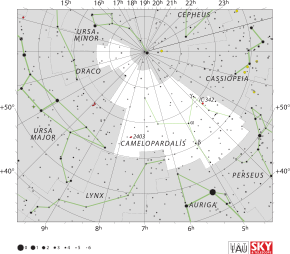| Constellation | |
 | |
| Abbreviation | Cam[1] |
|---|---|
| Genitive | Camelopardalis[1] |
| Pronunciation | /kəˌmɛləˈpɑːrdəlɪs/, genitive the same |
| Symbolism | Giraffe[1] |
| Right ascension | 03h 15m 36.2232s–14h 27m 07.8855s[2] |
| Declination | 86.0975418°–52.6655540°[2] |
| Area | 757 sq. deg. (18th) |
| Main stars | 2, 8 |
| Bayer/Flamsteed stars | 36 |
| Stars with planets | 4 |
| Stars brighter than 3.00m | 0 |
| Stars within 10.00 pc (32.62 ly) | 3 |
| Brightest star | β Cam (4.03m) |
| Messier objects | 0 |
| Meteor showers | October Camelopardalids |
| Bordering constellations | Draco Ursa Minor Cepheus Cassiopeia Perseus Auriga Lynx Ursa Major |
| Visible at latitudes between +90° and −10°. Best visible at 21:00 (9 p.m.) during the month of February. | |
Camelopardalis is a large but faint constellation of the northern sky representing a giraffe. The constellation was introduced in 1612 or 1613 by Petrus Plancius.[3][1] Some older astronomy books give Camelopardalus or Camelopardus as alternative forms of the name, but the version recognized by the International Astronomical Union matches the genitive form, seen suffixed to most of its key stars.[1]
- ^ a b c d e Ridpath 2001, pp. 92–93.
- ^ a b "Camelopardalis, constellation boundary". The Constellations. International Astronomical Union. Archived from the original on 4 June 2013. Retrieved 14 February 2014.
- ^ Knowledge Encyclopedia Space!. Dorling Kindersley Ltd. 2015. p. 164. ISBN 9780241245347. Archived from the original on 10 November 2023. Retrieved 14 September 2020.